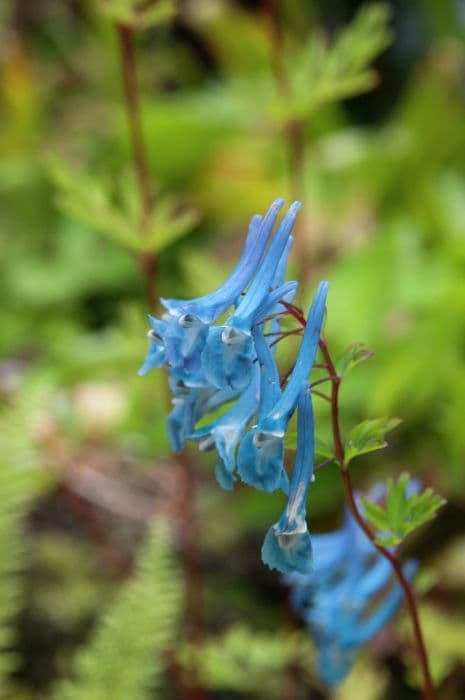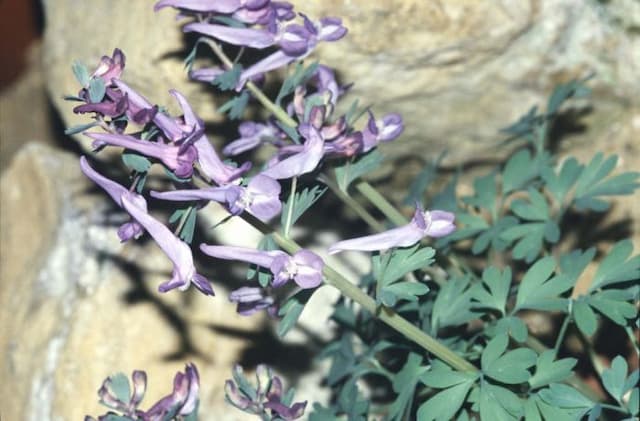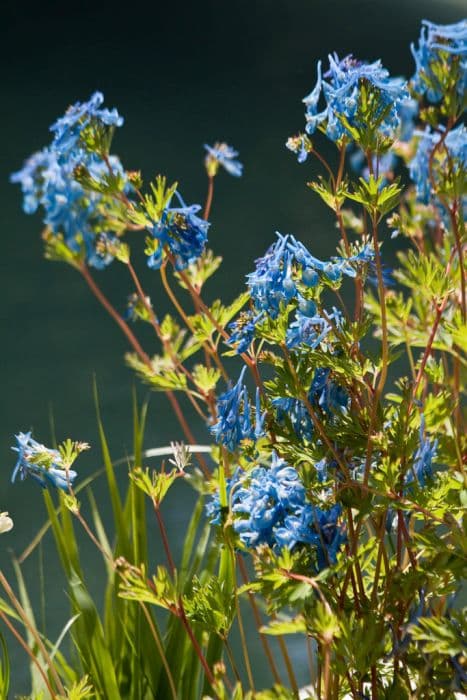Fumewort Corydalis solida subsp. solida

ABOUT
The plant in question features a delicate structure with a lush, leafy appearance. Its leaves are finely divided, creating a feathery or fern-like texture, mostly presenting in a shade of fresh green. The plant is adorned with charming flowers that often exhibit a rich, violet or purplish hue. These flowers typically take on a tubular shape and are arranged in a cluster, each bloom nodding or slightly inclined on slender stalks emerging amidst the foliage. The appearance of the blossoms can sometimes have a quality reminiscent of a small floral lantern, with petals that may display subtle nuances in color, ranging from more intense purples to softer lilac shades or even pinkish tones, often highlighted with contrasting colors at the petal's throat. The overall aspect of this plant gives it a feathery and quaint quality, fitting for ornamental purposes in a variety of garden settings.
About this plant
 Names
NamesFamily
Papaveraceae.
Synonyms
Fumewort, Bird-in-a-Bush, Hollowroot.
Common names
Corydalis bulbosa, Corydalis solida var. incisa, Corydalis solida var. longibracteata, Corydalis solida var. subincisa, Corydalis tommasiniana, Fumaria bulbosa, Fumaria solida.
 Toxicity
ToxicityTo humans
Fumewort (Corydalis solida subsp. solida) is not commonly listed among the highly poisonous plants to humans, but ingesting it can potentially cause mild to moderate digestive upset, as with many plants that are not typically intended for consumption. If fumewort is ingested, it may result in gastrointestinal discomfort, nausea, vomiting, or diarrhea. In significant quantities, the alkaloids present in the plant might cause more serious symptoms such as altered nervous system function. However, documented cases of poisoning in humans from fumewort are rare, and it is generally not considered a high-risk plant for human ingestion. Caution should still be exercised to prevent ingestion, particularly in children and pets.
To pets
Fumewort (Corydalis solida subsp. solida) possesses some toxic components that can affect pets if ingested. Pets may experience gastrointestinal upset, including symptoms like vomiting, diarrhea, or abdominal pain. While not considered among the most toxic plants to pets, it can still cause discomfort and illness. Ingesting large amounts may lead to more serious health issues such as tremors or changes in heart rate, although such severe reactions are uncommon. It is advisable to keep pets away from fumewort to avoid any potential adverse effects.
 Characteristics
CharacteristicsLife cycle
Perennials
Foliage type
Deciduous
Color of leaves
Green
Flower color
Varies
Height
6-12 inches (15-30 cm)
Spread
6-12 inches (15-30 cm)
Plant type
Bulb
Hardiness zones
5
Native area
Europe
Benefits
 General Benefits
General Benefits- Attracts Pollinators: Corydalis solida, commonly known as Fumewort, is known to attract bees and other pollinating insects, which is beneficial for the pollination of surrounding plants.
- Aesthetic Appeal: Fumewort adds color and beauty to gardens with its attractive foliage and brightly colored flowers, enhancing the visual appeal of the landscape.
- Spring Bloomer: As one of the early bloomers in spring, Fumewort provides an early source of nectar for insects and adds vibrancy to gardens after winter dormancy.
- Diversity in Shade Gardens: Fumewort is suitable for shaded areas where other plants may struggle, thus increasing the variety of plants that can be grown in these conditions.
- Erosion Control: With its ability to spread and form colonies, Fumewort can help stabilize soil and prevent erosion in certain garden settings.
- Low Maintenance: Fumewort generally requires minimal care once established, making it a good choice for gardeners who prefer low-maintenance plants.
- Non-Invasive: Although it can naturalize in an area, Fumewort is not considered invasive and typically does not disrupt local ecosystems.
- Companion Planting: Fumewort can be planted alongside other shade-loving perennials, where it can complement their bloom times and foliage.
 Medical Properties
Medical Properties- Analgesic: Corydalis solida may have properties that help in relieving pain.
- Sedative: There is some historical usage that suggests the plant might have sedative effects on the nervous system.
- Antispasmodic: The natural compounds found in Corydalis solida have been considered for their potential to alleviate spasms.
 Air-purifying Qualities
Air-purifying QualitiesThis plant is not specifically known for air purifying qualities.
 Other Uses
Other Uses- Corydalis solida, commonly known as Fumewort, can be used in floral arrangements, particularly by those who appreciate a natural woodland aesthetic.
- The plant's tuber is sometimes utilized by gardeners practicing vegetative propagation to grow new plants.
- Fumewort may serve as a natural dye source, providing a range of colors depending on the mordant used in the dyeing process.
- In some cultures, the plant is incorporated into rituals or ceremonies that are associated with spring, due to its early flowering habit.
- The seed pods of Fumewort, when ripe, can create a decorative effect in dry flower crafts due to their interesting shape.
- Amateur naturalists sometimes use the plant to attract and study pollinators in early spring, as it's one of the first flowers to bloom.
- Photographers might seek out Fumewort for its photogenic qualities, especially for macro photography in springtime settings.
- Due to its dense clumps, Fumewort can be used in garden design to create texture contrasts with other plants.
- The plant is sometimes used educationally, for teaching botany and the importance of spring ephemerals in temperate climates.
- Eco-friendly artists might use the delicate flowers of Fumewort in the creation of pressed flower artwork.
Interesting Facts
 Feng Shui
Feng ShuiThe Fumewort is not used in Feng Shui practice.
 Zodiac Sign Compitability
Zodiac Sign CompitabilityThe Fumewort is not used in astrology practice.
 Plant Symbolism
Plant Symbolism- Hope: Corydalis solida, commonly known as fumewort, often blooms early in spring, symbolizing hope and the promise of warmer days after a long winter.
- Resilience: Fumewort's ability to thrive in cold climates and push through the last of the winter snows represents resilience and the capability to overcome challenges.
- Transition: Fumewort's presence in the early spring garden embodies the transition from one season to another, marking cycles and the passage of time.
 Water
WaterFumewort (Corydalis solida), requires consistent moisture, especially during its growing season in the spring. The soil should be kept slightly moist but not waterlogged. During its dormancy in the summer, watering should be reduced. Typically, this plant needs about an inch of water per week, which might be roughly 0.6 gallons for a medium-sized plant, though this will depend on climate conditions. Ensure good drainage is provided to prevent root rot, and consider using rainwater if your tap water is hard.
 Light
LightFumewort thrives best in partial shade to full shade conditions. It should be planted in a spot that is shielded from the intense midday sun, such as under deciduous trees or to the north side of buildings where it can receive filtered sunlight or morning sun only. This ensures that the delicate foliage is protected and temperature extremes are minimized.
 Temperature
TemperatureFumewort is hardy and can tolerate a range of temperatures but performs best when the temperature is between 50°F and 75°F. It can survive minimum temperatures down to about -5°F. During the active growth period, protection from late spring frosts is beneficial. Ideal growing conditions mimic the plant's natural woodland habitat, which includes cool to moderate temperatures.
 Pruning
PruningFumewort generally requires little to no pruning. After flowering, the foliage naturally dies back as the plant goes dormant in the summer. At this point, any withered foliage can be removed to keep the garden tidy. It is not necessary to prune the plant for shaping or growth control.
 Cleaning
CleaningAs needed
 Soil
SoilFumewort thrives best in a rich, well-draining soil mix with a pH range of 6.0 to 7.5. A mix containing garden compost, loam, and sharp sand or perlite is ideal to mimic its natural woodland environment.
 Repotting
RepottingFumewort, being a perennial, does not need frequent repotting and it should be done every 3 to 4 years, or when the clumps become overcrowded.
 Humidity & Misting
Humidity & MistingFumewort prefers moderate to high humidity levels, similar to its native woodland habitat, but can tolerate a range of humidity conditions provided it is not too dry.
 Suitable locations
Suitable locationsIndoor
Provide bright, indirect light and keep the soil moist.
Outdoor
Plant in partial shade, moist soil, and shelter from wind.
Hardiness zone
3-8 USDA
 Life cycle
Life cycleThe life of C. solida subsp. solida, commonly known as Fumewort, begins when seeds are dispersed by ants, which are attracted by the seed's elaiosomes, in late spring. Seeds undergo a period of dormancy before germinating, usually requiring a cold period to break this dormancy. Upon germination in early spring, the plant develops a small tuber and a rosette of leaves. The leaves grow and the plant rapidly proceeds to bloom, producing pink to purple or sometimes white flowers that attract pollinators such as bees. After flowering, which occurs from early to mid-spring, the plant sets seed and then the above-ground portion dies back, as the plant enters a dormant phase during the summer months. The life cycle is completed underground with the tuber, which remains dormant until the next spring when the cycle restarts.
 Propogation
PropogationPropogation time
Spring
Corydalis solida, commonly known as Fumewort, is typically propagated through division or by seed. The most popular method of propagation is by seed, as the plant readily self-seeds in the garden. To propagate Fumewort by seed, one should collect the seed pods in late spring to early summer as they ripen. After collection, the seeds should be sown immediately as they lose viability quickly if they are allowed to dry out. The sowing is done by lightly pressing the seeds into a moist seed-starting mix and maintaining a consistent moisture level. The soil temperature should be around 55 to 59 degrees Fahrenheit (13 to 15 degrees Celsius) for optimal germination. Seedlings will often appear the following spring, and once they are large enough to handle, they can be transplanted to their final location in the garden.









